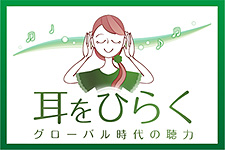New Articles: How Can We Hear Music If We Develop Our Auditory Sense?
2017/06/01 | コメント(0)
| トラックバック(0)
|
 How do you listen to your sound? How can we hear and recognize music if we become more aware of the potential of the auditory sense? A new series of articles began (written by Eriko Sugano, music journalist). Here is the summary of the 1st chapter.
How do you listen to your sound? How can we hear and recognize music if we become more aware of the potential of the auditory sense? A new series of articles began (written by Eriko Sugano, music journalist). Here is the summary of the 1st chapter.Researches show that the auditory sense is used only 7-11%, whereas the visual sense is used over 80% among all the five senses. In general, visual sense dominates our perception. However, when the visual and auditory information are misaligned, we begin to focus on the latter. Being more sensitive to our auditory sense might bring us long-term, three-dimensional, multi-layered way of perceiving things.
Basically, human beings are capable of receiving all the sound information, but do not perceive all of them. In other words, all the sounds are heard, but only part of them are recognized. Even if we hear the same music, it totally depends upon individuals how and what is heard. So, the way we hear sounds built up one's perception.
According to the scale of audible sounds (frequency), human beings can hear from 20 Hz to 20000 Hz. Among them, the range of music is wider than that of languages. For instance, piano is from 27.5 Hz to 4186 Hz. Hearing music would bring us a variety of sound vibrations, probably much more than we what hear in the surrounding environment.
(Sounds of nature are around 4000 Hz to 8000 Hz. A research reveals that hearing high frequency sounds which even exceed 20000 Hz would be good for our mind and body. They provide stimulus to our brain, and eventually improve our immune function system.)
(Sounds of nature are around 4000 Hz to 8000 Hz. A research reveals that hearing high frequency sounds which even exceed 20000 Hz would be good for our mind and body. They provide stimulus to our brain, and eventually improve our immune function system.)
Anyway, music is a way to deliver or exchange vibrations. And it has not been changed for hundreds of thousands of years. Homo neanderthalensis had a capability of uttering voices, and they did some musical activities like singing (humming, without lyrics). Even though they could not produce or understand any meaningful words, they could exchange emotions among their group members simultaneously. Music solidified their groups in a more efficient way than one-to-one grooming. On the other hand, Homo sapiens, which emerged a few eras later, had a capability of speaking as well as cognitive understanding and advanced social communication skills. Their prefrontal brain area, which functions to recognize meanings, became much developed so that they could produce arts and cultures.
The role of music was expanded as the lives of human beings evolved. In the ancient Greece, music was performed for ceremonies, feasts, theaters, etc. and used for education, math, astronomy, etc. Music was not only for exchanging emotions but also for knowing the truth of the universe. Thus, it had been studied as one of the liberal arts subjects throughout the Middle ages.
And nowadays, we know that music affects both to human emotions and intelligence. In other words, music affects both the right and the left sphere of a brain, and enhances neuronal connections. For those who study music, one may as well hear and internalize a variety of sounds or music first, then know the musical grammars, and integrate and output them with physical movements. Our auditory sense can be developed by listening carefully and sensitively to rhythm, melody, harmony, structure, sonority, etc. step by step, and that might develop our recognition and interpretation of music, expand imagination, and eventually refine our musical performances.
This serial article tries to explore the way to develop one's auditory sense and perception, and integrate them to music making.
【GoogleAdsense】